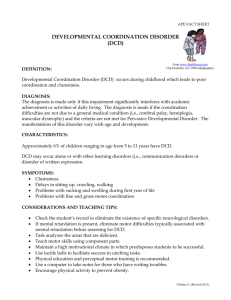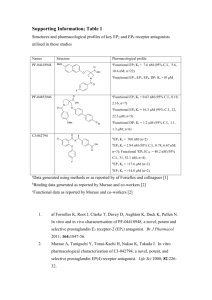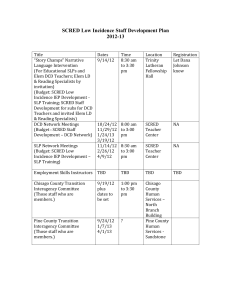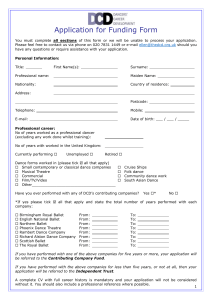Document 10812503
advertisement
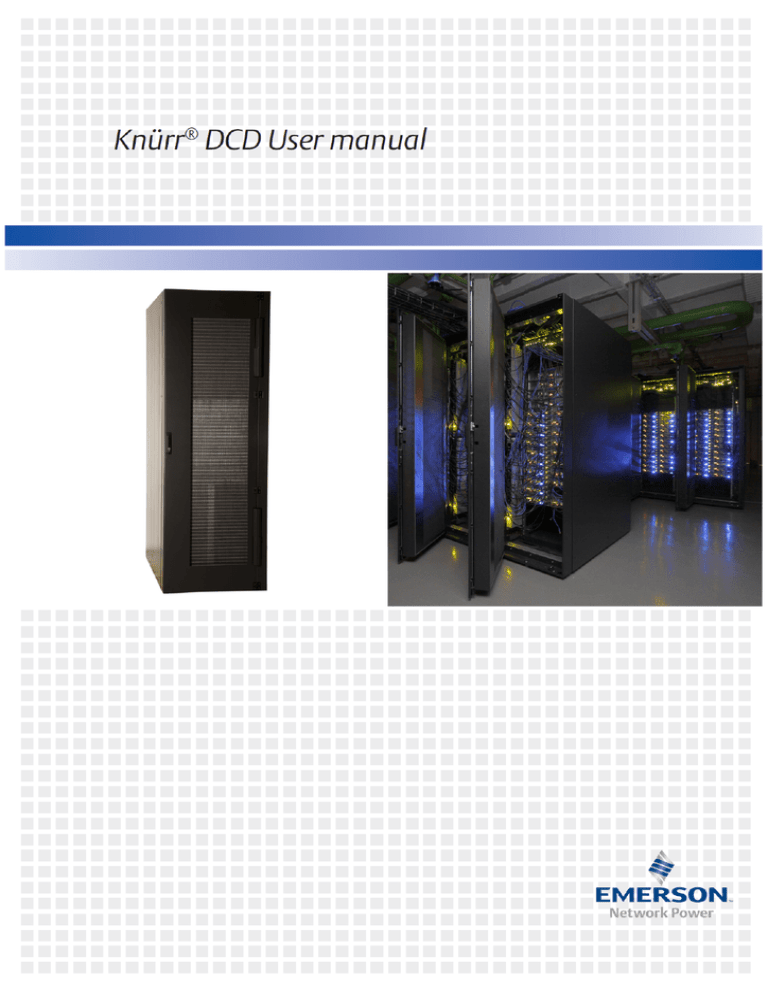
User manual Emerson Network Power DCD Knürr DCD Liebert DCD Rear door heat exchanger up to 35kW for mounting on a rack Date / Datum 24/11/14 Issue / Ausgabe 01.998.355.0.- Author / Erstellt Martin BLASS Reviewed / Geprüft Heiko EBERMANN Unit code and component location 1 D 2 C Model number - part 1/2 3 4 5 6 7 8 9 D 3 5 A 6 3 3 10 0 11 0 12 0 1. - 3. Product identification DCD = ENP DCD 4. - 5. Nominal cooling capacity 35 = 35 kW 6. Rack height A = 2000 mm (78 – 6/8”) B = 2100 mm (82 – 5/8”) 13 0 14 0 Model details 15 16 17 18 0 1 0 0 19 0 20 0 0 = No options (Not available at the moment) 11. – 15. Not in use 0 = No options (Not available at the moment) 16. Color 1 = RAL 7035 (light grey) M = modification (custom – SFA only) G = RAL 7021 (dark grey) 6 = 600 mm (23 – 5/8”) 22 X 10. Options C = 2200 mm (86 – 5/8”) 7. Rack width 21 S 2 = non standard color (SFA) 17. – 20. Not in use 7 = 700 mm (27 – 4/8”) 0 = No options (Not available at the 8 = 800 mm (31 – 4/8”) moment) M = modification (custom – SFA only) 8. Rack depth 21. Packaging P = Land freight – short distance E = 1000 mm (39 – 3/8”) (pallet, shrink wrap, cardboard F = 1100 mm (43 – 3/8”) protection) G = 1200 mm (47 – 2/8”) S = Seaworthy (air freight) – long rd 3 = 3 part rack adaptor 0 = no rack M = modification (custom – SFA only) 9. Chilled water connection – hinge position 1 = top – left 2 = top – right 3= bottom – left 4 = bottom – right distance (wooden crate) 22. SFA – special features X = SFAs included A = no SFAs 23. – 25. Order identifier Part 2/2 23 24 25 0 0 1 Fig. 1 Component location ENP DCD User manual Contents Unit code and component location .............................................................................................................. 3 Contents .......................................................................................................................................................... 5 List of figures .................................................................................................................................................. 6 List of tables ................................................................................................................................................... 7 0 Abstract .............................................................................................................................................. 8 1 Safety .................................................................................................................................................. 8 1.1 Symbols ............................................................................................................................................... 8 1.2 Safety notice ........................................................................................................................................ 9 2 Storage and transportation ............................................................................................................ 11 3 Installation and commissioning..................................................................................................... 12 3.1 Preparations for installation ............................................................................................................... 12 3.2 Piping and connection methods ........................................................................................................ 13 3.3 Assembly procedure and tools required ............................................................................................ 16 3.3 Chilled water connection ................................................................................................................... 30 3.4 Filling with water ................................................................................................................................ 31 3.5 Housing integrity ................................................................................................................................ 31 3.6 Application conditions ........................................................................................................................ 32 4 Description ....................................................................................................................................... 33 4.1 General function ................................................................................................................................ 33 4.2 Cooling principle ................................................................................................................................ 34 4.3 Submittal drawings ............................................................................................................................ 35 5 Variants and options ....................................................................................................................... 40 5.1 ENP DCD built in the server rack (Option – digit 8) .......................................................................... 40 5.2 Connection set ENP DCD (Separate product) .................................................................................. 41 6 Maintenance and repairs ................................................................................................................ 43 7 Disassembly and disposal ............................................................................................................. 44 8 Customer service ............................................................................................................................ 44 9 Annexes ............................................................................................................................................ 45 9.1 Quality Requirements for water used in the ENP DCD ..................................................................... 45 9.2 Checklist for Setting up the Device ..................................................................................................... 46 9.3 Commissioning Protocol .................................................................................................................... 47 9.4 ENP DCD – performance charts ....................................................................................................... 51 9.5 Unit conversion chart ......................................................................................................................... 53 ENP DCD 01.998.355.0 Page / Seite 5/54 ENP DCD User manual List of figures Fig. 1 Component location...................................................................................................................... 4 Fig. 2 Ring piping .................................................................................................................................. 13 Fig. 3 Tichelmann ring piping ............................................................................................................... 13 Fig. 4 Non - interlaced piping................................................................................................................ 14 Fig. 5 Floor cut outs - unit itself ............................................................................................................ 14 Fig. 6 Floor cut outs - unit with aluminium frame.................................................................................. 15 Fig. 7 Unpacking ENP DCD ................................................................................................................. 18 Fig. 8 Unpacking the ENP DCD (part of the rack) ................................................................................ 19 Fig. 9 Lifting the frame .......................................................................................................................... 20 Fig. 10 Marking the position ................................................................................................................. 20 Fig. 11 Inserting the spring nuts ........................................................................................................... 21 Fig. 12 Diamond nuts .......................................................................................................................... 21 Fig. 13 Hose piece adaptor .................................................................................................................. 22 Fig. 14 Position of the sealing foam ..................................................................................................... 22 Fig. 15 Tightening the screws .............................................................................................................. 23 Fig. 16 Installing the door ..................................................................................................................... 24 Fig. 17 Flexible piping........................................................................................................................... 25 Fig. 18 Inserting sealing rings .............................................................................................................. 25 Fig. 19 Tightening the union nuts ......................................................................................................... 26 Fig. 20 Piping connected ...................................................................................................................... 26 Fig. 21 Hinge covers orientation and position ...................................................................................... 27 Fig. 22 Outmost swivel joint covers connection points ......................................................................... 28 Fig. 23 Attaching the swivel joint covers .............................................................................................. 28 Fig. 24 Inside swivel joint covers .......................................................................................................... 29 Fig. 25 Attaching the grounding wire .................................................................................................... 29 Fig. 26 Chilled water connection .......................................................................................................... 30 Fig. 27 Bleeding point ........................................................................................................................... 31 Fig. 28 Top view of the rack equipped with ENP DCD ......................................................................... 33 Fig. 29 Side view of the rack equipped with ENP DCD ........................................................................ 34 Fig. 30 Submittal drawings – ENP DCD (right hinges) ......................................................................... 36 Fig. 31 Submittal drawings – ENP DCD (left hinges) ........................................................................... 37 Fig. 32 Aluminium frame submittal drawing ......................................................................................... 38 Fig. 33 Server rack with the ENP DCD ................................................................................................ 40 Fig. 34 Connection set.......................................................................................................................... 42 Fig. 35 Connection set - detail .............................................................................................................. 42 Fig. 36 Performance chart 1 ................................................................................................................. 51 Fig. 37 Performance chart 2 ................................................................................................................. 51 Fig. 38 Performance chart 3 ................................................................................................................. 52 Fig. 39 Air side pressure drop .............................................................................................................. 52 Fig. 40 Water side pressure drop ......................................................................................................... 53 ENP DCD 01.998.355.0 Page / Seite 6/54 ENP DCD User manual List of tables Tab. 1 List of tools required .................................................................................................................. 17 Tab. 2 Packaging list ............................................................................................................................ 17 Tab. 3 Operation conditions ................................................................................................................. 32 Tab. 4 Unit dimensions ......................................................................................................................... 35 Tab. 5 Aluminium frame dimensions .................................................................................................... 38 Tab. 6 Technical specifications ............................................................................................................ 39 Tab. 7 Hydrological requirements ........................................................................................................ 45 Tab. 8 Set up checklist ......................................................................................................................... 46 Tab. 9 Unit conversion.......................................................................................................................... 53 ENP DCD 01.998.355.0 Page / Seite 7/54 ENP DCD User manual 0 Abstract ENP DCD is an air - water heat exchanger that is integrated into the rear door of a server rack. The heat exchanger is suitable for absorbing heat loads from server racks of up to 35 kW. It can be configured in such way that no heat is released to the installation area. Cooling effect occurs when the server exhaust air passes through the heat exchanger in the rear section of the server rack. The cooling air is moved through the heat exchanger only by the server fans. ENP DCD thereby supports the cold room concept in which is the warm exhaust air from servers always led to a cooling device where its temperature is reduced to the temperature level of the server supply air. The supply air for chilled water system flows freely through the installation area. 1 Safety 1.1 Symbols Attention! Danger spot! Safety notice! Caution! Hot surface. Attention! Refers to possible damage to the device. Note! Marks possible hazards for the environment. Important note, information. ENP DCD 01.998.355.0 Page / Seite 8/54 ENP DCD User manual 1.2 Safety notice Our engineers can give you comprehensive advice in assembling the ENP DCD. Extensive material, functional and quality testing guaranty high benefit and a long lifecycle. Nonetheless, such devices may cause hazards if improperly handled by untrained personnel and if used for purposes they are not intended for. Carefully read this assembly and operational manual prior to assembling and commissioning the ENP DCD. Hazard by works on the device carried out by non-experts. Maintenance and cleaning operations are only permitted to be performed by trained personnel. In order to keep the device in operationally safe condition and to grant its long lifecycle, maintenance and cleaning intervals must be fulfilled by all means. Operate the ENP DCD only in accordance with its specified purpose, within its limits of capacity and approved operating means. When performing any works on and with the device, please mind: • Any respectively applicable regulations (e.g. VDE regulations or other nationally applicable guidelines) • Any applicable accident prevention regulations (BGV) • Any respective provisions • Any applicable environment protection acts Operate the device only in its proper condition. In the event of functional disturbances or deficiencies, the device must immediately be taken out of operation and the operator’s responsible person must be informed of its state. The device must only be taken into operation again after the flawless function of the device has been restored. ENP DCD 01.998.355.0 Page / Seite 9/54 ENP DCD User manual Caution! Hot surface! Defect fans, power supply units or control boards may have run hot. Allow them to cool down before commencing any operations. ENP DCD 01.998.355.0 Page / Seite 10/54 ENP DCD User manual 2 Storage and transportation • Keep the device in its original packaging, protected from the weather and in dry conditions • Protect the working parts from dirt (e.g. sand, rain, dust, etc.) • Store at temperatures between -30 °C and +50 °C (-22 °F and +122 °F) • Chilled water circuit must be empty during storage (risk of frost damage) • After long period of storage (1 year +) inspect functionality of water – bearing hinges • Remove all the packaging before commencing operation of the device • Chilled water connections are not to be used as a transport handles • When transporting always make sure the device is properly fastened and secured against slipping Dry net weight +/- 5% kg (lb) Width DCD 600 mm 700 mm ~ 95 kg / ~ 210 lb 800 mm Land freight packaging +40 kg / +88 lb Seaworthy packaging +125 kg / +276 lb Tab. 1 Unit weight ENP DCD 01.998.355.0 Page / Seite 11/54 ENP DCD User manual 3 Installation and commissioning 3.1 Preparations for installation Before installing the device it is crucial You check each of the following points. These checks will ensure safe and trouble free operation of ENP DCD. Perform these tests with great care. • Check the device for shipping damage Packaging may not appear to have been damaged; however, it is necessary to inspect the device before proceeding to installation. Ignoring this advice may at worst lead to a functional failure. (When returning the device because of the shipping damage – If the device is not being sent in its original, packaging please make sure the distance between the device and the new packaging is at least 30 mm ~ 1.18 in) • Qualified installation Please find the checklist enclosed in the annex to help with installation. Commissioning can also be done by specialised company. In this case please find the commissioning protocol enclosed in the annex. • Room Preparation The room should be well-insulated and must have a sealed vapour barrier. The vapour barrier in the ceiling and walls can be a polyethylene film. Paint on concrete walls and floors should contain either rubber or plastic. The vapour barrier is the single most important requirement for maintaining environmental control in the conditioned space. ENP DCD 01.998.355.0 Page / Seite 12/54 ENP DCD User manual 3.2 Piping and connection methods If possible when using a chilled water distribution unit such as the Knürr CoolTrans or the Liebert XDPW, connect the ENP DCD in an “ring” configuration (see Fig. 1) or Tichelmann ring (Fig. 2) In this system the pressure drop for each of the units is approximately the same which results in even cooling performance. Fig. 1 Ring piping Fig. 2 Tichelmann ring piping However, if it is not possible, connect the ENP DCD units in a non-interlaced configuration as seen in Fig. 3. ENP DCD 01.998.355.0 Page / Seite 13/54 ENP DCD User manual Fig. 3 Non - interlaced piping It is recommended to add a set of 2 ball valves to each unit (supply and return pipe) to allow the unit to be disconnected from the system for repairs and maintenance without taking the whole system down. Fig. 4 Floor cut outs - unit itself ENP DCD 01.998.355.0 Page / Seite 14/54 ENP DCD User manual Fig. 5 Floor cut outs - unit with aluminium frame ENP DCD 01.998.355.0 Page / Seite 15/54 ENP DCD User manual 3.3 Assembly procedure and tools required Assembly of the ENP DCD must be carried out in vertical position of the device. Please use a level to make sure this requirement is met when commencing the installation. ENP DCD and the rack must be vertically aligned to provide proper functionality. Strict separation between the hot and cold air within the case must exist. To ensure suficient air circulation please make sure there are no obstructions (e.g. packaging materials, tools etc.) left in… • Grids • Heat exchanger • Air intake • Air outlet This guideline only applies if you have bought ENP DCD as a separate product (not being part of a rack already). If you bought the ENP DCD as a part of the rack it would come already assembled. (In this case please proceed (after unpacking – Fig. 7) to attaching the hose adaptor piece from beneath Fig. 12). The procedure described is valid for Knürr racks (DCM) only. Installation and commissioning of the ENP DCD must be performed only by qualified personnel. All actions must be in accordance with regulations and instructions of the manufacturer. Warning! Protective equipment (e.g. boots) must be worn during installation and maintenance of this device. Please check your local regulations on using safety equipment before commencing any operations. This procedure also requires at least 2 persons to complete. The unit weighs 95 kg (approx. 210 pounds) ENP DCD 01.998.355.0 Page / Seite 16/54 ENP DCD User manual Tab. 2 List of tools required Socket hexagonal screw driver - 8 mm (5/16”)(for M5 screws) Open – jaw wrench 41 mm (1-5/8”) Open – jaw wrench 36 mm (1-7/16”) Phillips screw driver PH3 Utility knife Forklift, pallet jack (or similar device) Tab. 3 Packaging list Component description ST mounting bracket for miracel+ ST mounting bracket for miracel+ ST cover swivel-joint fixed compo ST cover swivel-joint fixed compo ST cover swivel-joint door compon ST cover swivel-joint door compon ST foam UL94-HF1 20mmx32mm ST Condensate Drain-Set individual components 1 1 7 6 8 ST Wire - Grounding 250/6 RA5xRA5 ST EARTH WIRE 200/6 RA5xFH6,3pl ST M5 TENSILOCK NUT ST M5 MOUNTING NUT-MIR.EXTRUSION ST washer M5 bag nr.1 30 ST Star Screw M5x10 bag nr. 2 16 ST Spring Nut M5 broad bag nr. 3 8 ST DIN965 M6x16 bag nr. 4 Quantity 1 1 1 1 1 1 1 1 To unpack ENP DCD (shipped separately) follow the instructions shown in Fig. 6. ENP DCD 01.998.355.0 Page / Seite 17/54 ENP DCD User manual Fig. 6 Unpacking ENP DCD To unpack the ENP DCD as a part of the rack follow instructions show in Fig. 7. ENP DCD 01.998.355.0 Page / Seite 18/54 ENP DCD User manual Fig. 7 Unpacking the ENP DCD (part of the rack) ENP DCD 01.998.355.0 Page / Seite 19/54 ENP DCD User manual 1 After removing the packaging, first lift the ENP DCD frame of the pallet (Fig. 8). At this point the door and the frame are not fixed together yet. Fig. 8 Lifting the frame 2 Then align the frame of the ENP DCD to server rack properly. Mark the positions of the frame holes (there are 16 holes) on the aluminium profile of the server rack and put the frame aside again. Fig. 9 Marking the position 3 After that, insert the spring nuts into the groove of the rack aluminium profile in to previously marked position (Fig. 10). ENP DCD 01.998.355.0 Page / Seite 20/54 ENP DCD User manual Fig. 10 Inserting the spring nuts 4 Insert 3 diamond nuts into the grove of each horizontal member of the rack aluminium profile in the previously marked position (Fig. 11). Fig. 11 Diamond nuts 5 Before proceeding to the next step, connect the hose adaptor piece (5/8 “) into the condensate tray (remove the white plastic plug first) (Fig. 12). ENP DCD 01.998.355.0 Page / Seite 21/54 ENP DCD User manual Fig. 12 Hose piece adaptor 6 In the next step place the adhesive strip of foam (included) on the rack’s aluminium profile (hinge side) in such way that when the ENP DCD frame is in the position the foam strip will seal the gap between rack and the ENP DCD frame (It might be necessary to trim the foam strip with utility knife) (Fig. 13). Fig. 13 Position of the sealing foam ENP DCD 01.998.355.0 Page / Seite 22/54 ENP DCD User manual 7 Now you can start attaching the frame of ENP DCD to the rack using the socket screw driver (Fig. 14). Tighten the screws all around the perimeter of the frame, first lightly and then to 3 Nm (2 pound foot). This is the only way to prevent the frame from twisting and to ensure the parts fit properly. Fig. 14 Tightening the screws Make sure there is no twist in the frame before proceeding. The next step in installation is to attach the heat exchanger door to the frame. Attention! Risk of injury! The heat exchanger door is very heavy (95 kg, approx 210 pounds). At least 2 persons are required for manipulation with the door. 8 Carefully align the door to the frame and insert the door into the frame (Fig. 15). ENP DCD 01.998.355.0 Page / Seite 23/54 ENP DCD User manual Fig. 15 Installing the door 9 Hinges are already attached to the door. Fasten them to the frame of the ENP DCD using the Phillips screw driver. Then check if the door moves freely all the way. If you notice any irregularities or roughness in the movement of the door, check for obstructions or loosen the screws of the hinges and tighten them again. (The rough movement might have occurred because of the twist in the hinges). 10 Pull the flexible piping slightly to elongate. This allows the piping enough length to connect the union nuts. ENP DCD 01.998.355.0 Page / Seite 24/54 ENP DCD User manual Fig. 16 Flexible piping 11 Before connecting the heat exchanger (in the door) with the pipe work in the frame of the ENP DCD, put sealing rings in this connection (Fig. 17). Use two wrenches when tightening the union nuts to reduce the stress on the pipes (Fig. 18). Torque value for this connection is 85 Nm (64 foot/pound). Fig. 17 Inserting sealing rings ENP DCD 01.998.355.0 Page / Seite 25/54 ENP DCD User manual Fig. 18 Tightening the union nuts Fig. 19 Piping connected 12 Check again if the door is moving freely at this point. If so you can attach the swivel joint covers. ENP DCD 01.998.355.0 Page / Seite 26/54 ENP DCD User manual 13 The two outmost swivel joint covers are to be attached to the hinge side of the door. The two inside swivel joint covers are to be attached to the hinge side of the frame (Fig. 21). Use hexagonal screw driver to fasten the screws. Correct orientation of the hinge covers is indicated by slotted holes (See picture). Fig. 20 Hinge covers orientation and position ENP DCD 01.998.355.0 Page / Seite 27/54 ENP DCD User manual Fig. 21 Outmost swivel joint covers connection points Fig. 22 Attaching the swivel joint covers 14 Locate the inside swivel joint cover connection points. The two inside swivel joint covers are to be attached to the hinge side of the frame. Correct orientation of the hinge covers is indicated by a sticker on the covers themselves. Use hexagonal screw driver to fasten the screws (Fig. 22) ENP DCD 01.998.355.0 Page / Seite 28/54 ENP DCD User manual Door Door Fig. 23 Inside swivel joint covers 15 In the last step connect the grounding wire of the door to the frame of the ENP DCD (Fig. 24). Fig. 24 Attaching the grounding wire Check if this connection is alright (e.g. by using “diode” or continuity test on a multimeter). 16 Check functionality of the door lock. ENP DCD is equipped with DIRAK 1333 lock. It is a ½” inch cylinder lock. Keys are provided. ENP DCD 01.998.355.0 Page / Seite 29/54 ENP DCD User manual 3.3 Chilled water connection Check the chilled water system for leaks visually before commissioning. Please check the chilled water pipe connection to the heat exchanger regularly. Tighten this connection if necessary. When setting up the heat exchanger for the first time please inspect the mechanical condition of the chilled water supply and connection thoroughly. (Note: Using the optional connection set (chapter 5.2) improves the ventilation and enables chilled water flow monitoring and regulation) There is a risk of frost damage to the device during longer stops (e.g. storing etc.) Make sure the heat exchanger and the supply pipes are free of any water (use compressed air if necessary) and remove all the vents and the screws before storing. The coil and piping can be damaged due to thermal expansion of the cooling fluid with no means of expansion (e.g. closing the ball valves on both the supply and the return pipes). Always allow for thermal expansion either by leaving at least one of the valves open or by opening the bleeding valve on the door. Supply and return pipes are marked by label on the unit itself. Torque value for this connection is 85 Nm (64 foot/pound). Fig. 25 Chilled water connection ENP DCD 01.998.355.0 Page / Seite 30/54 ENP DCD User manual For water supply from the bottom left or top right of the position, the supply water connection is the outward pipe. The return water connection is then the position towards the rack. With water connection from top-left or bottom right, the water supply connection is the pipe towards the rack. The return pipe then has the position toward the outside. 3.4 Filling with water If using a chilled water distribution unit such as the Knürr CoolTrans or Liebert XDPW, refer to its user manual for instructions on filling the ENP DCD and starting the system. Heat exchanger fluid volume is approximately 12 liters (3.17 US Gal.) Bleeding the air off the system 1. Find the bleeding valve. This valve is located on the upper door piping (seeFig. 26 ). 2. Manually depress the pin to open the valve. 3. Keep the air bleed valve open until the eater coming out has no bubbles. Fig. 26 Bleeding point 3.5 Housing integrity To provide optimal cooling function following requirements must be met • Strict separation between the hot and cold air must exist within the rack • All the bushings (cable lines, piping etc) must be sealed to prevent any leakages ENP DCD 01.998.355.0 Page / Seite 31/54 ENP DCD User manual 3.6 Application conditions Appropriate use The device is a rear door heat exchanger for a server cabinet with integrated chilled water piping. The server fans themselves remove the heat from the racks to protect the temperature sensitive components in the rack. The waste heat from inside of the rack is transferred via the chilled water circuit to the outside and passed to the onsite chilled water system. For reliable function of the ENP DCD, chilled water must be available in an appropriate amount, at the appropriate temperature and pressure. The water quality must be in accordance with VGB-R 455 P. (see Annex) Tab. 4 Operation conditions Operating ambient temperature 10 °C ÷ 35°C (other temperatures on request) 50 °F – 95 °F Maximum absolute air humidity on site 8 Chilled water temperature intake 12 °C, 53.6 °F (other temperatures on request) Chilled water temperature outlet 18 °C, 64.4 °F (other temperatures on request) Water temperature difference 6 K, 10.8 °F Use of antifreeze Not recommended (on request) Chilled water connection Rack – rear side (top or bottom connection) 1” female threaded (DIN ISO 228 - 1) Condensate tray drain connection Rack – rear side Maximum operating pressure 10 bar (145 psi) g ⋅ kg −1 The cold water supply temperature should be higher than the dew point temperature of the installation space. ENP DCD is designed only for sensible cooling; dehumidification of the room by means of ENP DCD should be avoided. The built in condensate tray with condensate drain is designed only for a short-term condensation. ENP DCD 01.998.355.0 Page / Seite 32/54 ENP DCD User manual 4 4.1 Description General function The design of ENP DCD allows installation in the back of a server cabinet. Heat produced by internal components (e.g. servers etc.), is reliably removed by the door with built-in chilled water system. The cooling system is completely safe so that no water get into the server area. The cooling system consists of a high efficiency air - water heat exchanger. By operating as a rear door heat exchanger with an appropriate design (see Appendix) no heat (thermal load) in the surrounding area is given. Attention! The cooling with ENP DCD works only if a strict air separation exists between server cold air intake and server warm air outlet. Unused rack spaces must be sealed with empty plates. Fig. 27 Top view of the rack equipped with ENP DCD ENP DCD 01.998.355.0 Page / Seite 33/54 ENP DCD User manual 4.2 Cooling principle Fig. 28 Side view of the rack equipped with ENP DCD Air heated by the server (e.g. 40 °C, 104 °F), is forced through the special air – water heat exchanger. In the heat exchanger the air is cooled down to e.g. 20 °C – 25 °C (68 °F – 77 °F). The server fans force the cooling air through the heat exchanger of ENP DCD. The “pressure drop - flow rate” dependency curve is shown in the Appendix (9.4). Prior to using ENP DCD the system and the servers must be checked whether they match hydraulically. In particular, the server fans must be able to generate sufficient pressure to drive the air through the ENP DCD. The chilled water is provided by chilled water onsite distribution. In case of chilled water supply system failure the cooling is provided either by adjacent ENP DCDs and / or the installation room cooling system. In this case the server waste heat is released into the installation room. ENP DCD 01.998.355.0 Page / Seite 34/54 ENP DCD User manual 4.3 Submittal drawings Tab. 5 Unit dimensions 2000 mm (78-3/4") 2200 mm (85-3/4") B=1954mm C=600mm D=493mm B=2176mm C=600mm D=493mm 600 mm F=322mm G=151mm H=120mm F=322mm G=151mm H=120mm (23-5/8") I=45mm J=40.7mm K=24mm I=45mm J=40.7mm K=24mm L=52mm M=73mm N=25mm L=52mm M=73mm N=25mm B=77-7/8“ C=23-5/8“ D=19-3/8“ B=85-3/4“ “ C=23-5/8“ D=19-3/8“ F=12-5/8“ G=6” H=4-6/8” F=12-5/8“ G=6” H=4-6/8” I=1-6/8” J=1-5/8” K=1” I=1-6/8” J=1-5/8” K=1” L=2” M=2-7/8” N=1” L=2” M=2-7/8” N=1” B=1954mm C=700mm D=593mm B=2176mm C=700mm D=593mm F=372mm G=151mm H=120mm F=372mm G=151mm H=120mm 700 mm I=45mm J=40.7mm K=24mm I=45mm J=40.7mm K=24mm (27-1/2") L=52mm M=73mm N=25mm L=52mm M=73mm N=25mm B=77-7/8“ C=27-1/2“ D=23-3/8“ B=85-3/4“ C=27-1/2“ D=23-3/8“ F=14-5/8“ G=6” H=4-6/8” F=14-5/8“ G=6” H=4-6/8” I=1-6/8” J=1-5/8” K=1” I=1-6/8” J=1-5/8” K=1” L=2” M=2-7/8” N=1” L=2” M=2-7/8” N=1” B=1954mm C=800mm D=693mm B=2176mm C=800mm D=693mm F=422mm G=151mm H=120mm F=422mm G=151mm H=120mm 800 mm I=45mm J=40.7mm K=24mm I=45mm J=40.7mm K=24mm (31-1/2") L=52mm M=73mm N=25mm L=52mm M=73mm N=25mm B=77-7/8“ C=31-1/2“ D=27-1/4“ B=85-3/4“ C=31-1/2“ D=27-1/4“ F=16-5/8“ G=6” H=4-6/8” F=16-5/8“ G=6” H=4-6/8” I=1-6/8” J=1-5/8” K=1” I=1-6/8” J=1-5/8” K=1” L=2” M=2-7/8” N=1” L=2” M=2-7/8” N=1” Please find the reference to the dimensions stated in this table in the Fig. 29 and Fig. 30. ENP DCD 01.998.355.0 Page / Seite 35/54 ENP DCD User manual Fig. 29 Submittal drawings – ENP DCD (right hinges) (1 mm = 0,0394 in.) ENP DCD 01.998.355.0 Page / Seite 36/54 ENP DCD User manual Fig. 30 Submittal drawings – ENP DCD (left hinges) (1 mm = 0,0394 in.) ENP DCD 01.998.355.0 Page / Seite 37/54 ENP DCD User manual Fig. 31 Aluminium frame submittal drawing (1 mm = 0,0394 in.) Tab. 6 Aluminium frame dimensions [mm] [in] B=592mm C=1954mm D=65.9mm E=53.5mm B=23-2/8" C=76-7/8" D=2-5/8" E=2-1/8" F=49.5mm G=48.7mm H=37.7mm I=22.6mm F=2" G=1-7/8" H=1-1/2" I=7/8" J=20.5mm K=18.6mm L=15mm M=20.6mm J=6/8" K=6/8" L=5/8" M=6/8" N=7.9mm ENP DCD N=2/8" 01.998.355.0 Page / Seite 38/54 ENP DCD User manual Tab. 7 Technical specifications Cooling air side Housing material Steel plate (powder coated) Operating ambient temperature 10 °C ÷ 35°C (50 °F – 95 °F) (other temperatures on request) Maximum absolute air humidity on site 8 Air outlet temperature 18 °C ÷ 27 °C (64.4 °F – 80.6 °F) g ⋅ kg −1 (in accordance with ASHARE) Air temperature difference IN - OUT 15 K ÷ 20 K Chilled water side Cooling performance 35 kW Chilled water temperature inlet 12 °C ÷ 18 °C (53.6 °F – 64.4 °F)(other temperatures on request) Chilled water temperature outlet 18 °C ÷ 24 °C (64.4 °F – 75.2 °F)(other temperatures on request) Maximum operating pressure 10 bar (145 psi) Pipe connection IN / OUT 1” F (on the frame) (DIN ISO 228 - 1) ENP DCD 01.998.355.0 Page / Seite 39/54 ENP DCD User manual 5 Variants and options 5.1 ENP DCD built in the server rack (Optional) ENP DCD is typically delivered as a part of a specially prepared server rack. The DCM server rack offers guaranteed air separation between the hot and the cold air within the cabinet. (For a detailed description check the “Knürr DCM” manual) Fig. 32 Server rack with the ENP DCD ENP DCD 01.998.355.0 Page / Seite 40/54 ENP DCD User manual 5.2 Connection set ENP DCD (Optional) This set is for recommended connection of the ENP DCD with the on site chilled water system. ENP DCD connection set consists of • Reinforced hose with nickel - plated connections EPDM resistant to water and anti freeze Temperature range 0 °C ÷ 110 °C (32 °F – 230 °F) Maximum operating pressure 10 bar (145 psi) Inner diameter 25 mm (1”) Connection 1” F / 1” M (DIN ISO 228 - 1) Length 1500 mm (59,1”) (1 mm = 0,0394 in.) • Ball valve with fitting Ventilation and drain connection ¾”; possibility of pressure and temperature measurements. Connection • 1” F (DIN ISO 228 - 1) Shut off and regulation valve Discharge vent ¾”; possibility of pressure and temperature measurements. Connection ENP DCD 1” F (DIN ISO 228 - 1) 01.998.355.0 Page / Seite 41/54 ENP DCD User manual Connection to the ENP DCD Chilled water outlet (hot) Chilled water intake (cold) Connection to the on site chilled system Fig. 33 Connection set Ball valve - 1“connection Ventilation and drain connections (Pressure and temperature measurements possible) Bleeding and ventilation point (Flow rate measurements possible) Shut off and regulation valve (Flow rate measurements possible) Fig. 34 Connection set - detail (Note: All parts of the set are supplied as individual parts and are connected by the customer) ENP DCD 01.998.355.0 Page / Seite 42/54 ENP DCD User manual 6 Maintenance and repairs All maintenance and repair jobs are to be performed by qualified personnel only. All actions must be in accordance with regulations and instructions of the manufacturer. For maintenance and repair jobs use only the tools and spare parts approved by manufacturer of the device. Before commencing any work on the chilled water system let the system drain. General maintenance actions to be carried out • Check the heat exchanger pollution (dust etc.) • Check functionality of the valves • Check the chilled water system for leaks visually Please note that dirt (dust layer etc.) on the heat exchanger reduces the performance of the device (increased pressure loss, worse heat transfer). Vacuum cleaner, soft brush, or compressed air can be used to clean the fins of the heat exchanger. ENP DCD 01.998.355.0 Page / Seite 43/54 ENP DCD User manual 7 Disassembly and disposal Disassembly of the ENP DCD may be performed by qualified personnel only. Shut down the chilled water system before disassembly and prevent it from restarting. Dispose all the components and parts in accordance with local waste management and regulations. We recommend a recycling company. All components consist of: 8 • Aluminium, steel, brass, copper • Marked plastic components Customer service All Knürr products are subject to continuous quality control and comply with applicable regulations. For any questions you have related to our products, please contact the manufacturer of your system directly: Knürr GmbH Glashüttenstraße 1 01623 Lommatzsch Tel.: +49 (0) 800 000 6295 Email: service@knuerr.com ENP DCD 01.998.355.0 Page / Seite 44/54 ENP DCD User manual 9 9.1 Annexes Quality Requirements for water used in the ENP DCD In order to safeguard the maximum lifetime of air/water heat exchangers, the water applied for chilling purposes must meet the VGB Chilled Water Guidelines (VGB-R 455 P). The chilled water used must be soft enough to prevent deposits, but it must not be too soft which would lead to corrosion of the heat exchanger. The following table contains the most important impurities and counter-measures for their removal: Water impurity Mechanical impurity (dp < 0.3 mm) Excess hardness Moderate level of mechanical impurities and hardeners Moderate level of chemical impurities Biological impurities (bacteria and algae) Method for removal Filter the water Soften the water by ion exchange Add dispersion or stabilizing agents Add deadening agents and inhibitors Add biocides It is recommended to get as closest as possible to the following hydrological parameters: Tab. 8 Hydrological requirements Hydrological data pH values Carbonate hardness Free carbon dioxide Combined carbon dioxide Aggressive carbon dioxide Sulphides Oxygen Chloride ions Sulphate ions Nitrates and nitrites COB Ammonia Iron Manganese Conductivity Solid residue from evaporation Potassium manganese consumption Suspended matter (partial flow cleaning is recommended) (permanent cleaning) ENP DCD (7 ÷ 10,5) (3 ÷ 8) (8 ÷ 15) (8 ÷ 15) 0 < 10 < 50 < 250 < 10 <7 <5 <5 < 0.2 < 0.2 < 30 < 500 < 25 <3 (3 ÷ 15) > 15 01.998.355.0 °dH mg/dm3 mg/dm3 mg/dm3 mg/dm3 mg/dm3 mg/dm3 mg/dm3 mg/dm3 mg/dm3 mg/dm3 mg/dm3 mg/dm3 µS/cm mg/dm3 mg/dm3 mg/dm3 mg/dm3 mg/dm3 Page / Seite 45/54 ENP DCD User manual 9.2 Checklist for Setting up the Device Tab. 9 Set up checklist Performed checks Done Remarks (to be signed upon completion) Check device for damage upon receipt. Check the ground for being horizontal. Check bearing capacity of ground. Add-on and align, connect to server cabinet, position feet of the rack and adjust them horizontally Cables connected with server cabinet: - Temperature sensors (optional) - Server shut-down (optional) - Door contact (optional) Unit connected with set of external valves (optional): - Valve drive - Flow meter with temperature sensors (optional) Optional automatic door opening adjusted at server cabinet No remainders of packaging inside ENP DCD All assembly tools removed Bushings into the device proper and air-tight Chilled water connection leak-proof / pressure-tested Chilled water system de - aerated Volume flow of chilled water adjusted Condensed water line unobstructed Smell trap of chilled water system functional Condensate tray connected to condensed water line All front panels closed (air ducts technically separated) ............................................. Place: ENP DCD ........................................ Date: 01.998.355.0 .................... Signature of Tester Page / Seite 46/54 ENP DCD User manual 9.3 Commissioning Protocol ENP DCD Commissioning Protocol 1 General Details 1.1 Customer/Site of installation Customer’s name: ……………………….. Customer’s address: ……………………….. ……………………….. ……………………….. 1.2 Contact partner: ……………………….. Phone number: ……………………….. Site of installation / room number: .................................. Humidity at site of installation: ................................... % rel. humidity Ambient temperature ................................... ° C Configuration Cabinet type: ENP DCD 35 kW □ Commissioning number (if applicable): ................................... Serial number: ................................... Special remarks: ......................................................................................................................................... ......................................................................................................................................... ......................................................................................................................................... 2 State Check 2.1 General State Customer’s proof of bearing capacity of ground / transport ways Check of alignment Transport damage to housing: ENP DCD yes 01.998.355.0 □ □ □ no Page / Seite □ 47/54 ENP DCD User manual Remarks ......................................................................................................................................... ......................................................................................................................................... ......................................................................................................................................... 2.2 Residual packaging removed: yes □ no □ Assembly tools removed: yes □ no □ Air ducts checked: (Server cabinet front plates closed… ) yes □ no □ □ without anti-freeze □ Chilled Water System within the Facility Chilled water: with anti-freeze ENP DCD Connected to: CTU Circuit in building, direct □ □ cold water system, direct Chilled water temperature (primary): Feed: ......... °C Return: ......... °C Chilled water pressure Feed: ......... bar Return: ......... bar □ Connection: with Knürr connection set set of external valves □ □ Customer’s hydraulic plant OK (visual check): Remarks: ENP DCD □ yes no □ …………………………………………………….. 01.998.355.0 Page / Seite 48/54 ENP DCD User manual 3 3.1 Functional Check Mechanical Functions Damage to heat exchanger/ existing Connections/ lamellas / surface: none Remarks: ......................................................................................................................................... □ □ □ □ □ □ □ □ □ □ □ □ □ □ Front door, closing: yes no Remarks: ......................................................................................................................................... Rear door, closing: yes no Remarks: ......................................................................................................................................... no Pipe duct inlets / cable bushings closed: yes Remarks: ......................................................................................................................................... Condensed water drain open / connected: yes no remarks: ......................................................................................................................................... Fans run perfectly (bearings OK) Visual check yes no Remarks: ......................................................................................................................................... 3.2 Thermodynamic Checks Condensed water forming at heat exchanger yes no Remarks: ......................................................................................................................................... Chilled water entering heat exchanger: ...............° C Chilled water leaving heat exchanger: ...............° C Cabinet temperature in front of heat exchanger: ...............° C Cabinet temperature behind of heat exchanger: ...............° C ENP DCD 01.998.355.0 Page / Seite 49/54 ENP DCD User manual yes □ no □ Pressure of chilled water network tested: (customer’s protocol available) yes □ no □ Volume flow adjusted: yes □ no Chilled water network bleeded: external Water flow: …………. l / min external □ □ □ Remarks: ......................................................................................................................................... Correctness of above values is hereby confirmed. Commissioning was performed during on-going operation. yes □ no □ ......................................... Commissioning firm ................................ Date ............................................. Signature ......................................... Customer ................................ Date .............................................. Signature ENP DCD 01.998.355.0 Page / Seite 50/54 ENP DCD User manual 9.4 ENP DCD – performance charts Performance diagrams Fig. 35 Performance chart 1 Fig. 36 Performance chart 2 ENP DCD 01.998.355.0 Page / Seite 51/54 ENP DCD User manual Fig. 37 Performance chart 3 Fig. 38 Air side pressure drop ENP DCD 01.998.355.0 Page / Seite 52/54 ENP DCD User manual Fig. 39 Water side pressure drop 9.5 Unit conversion chart Tab. 10 Unit conversion 1 mm 0.0394 in 1 kg 2.205 lbs 1 bar 14.504 psi [°F] ([°C ] ⋅ 1.8) + 32 ENP DCD 01.998.355.0 Page / Seite 53/54 ENP DCD User manual ENP DCD 01.998.355.0 Page / Seite 54/54
